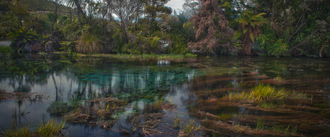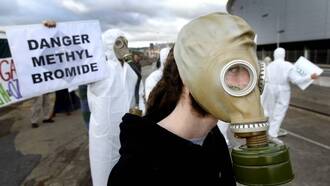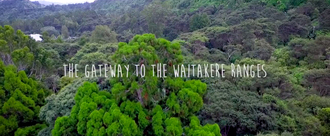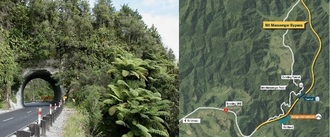-
Uphold Te Tiriti and Protect Pūtiki BayPūtiki is a taonga, a cultural repository, a wāhi tapu, a bay lined with pā sites on headlands, 500+ year old pohutukawa trees, a traditional kai moana gathering space. It is a landing site of Te Arawa and Tainui waka, therefore the ancestral waters of every Māori who whakapapa back to these waka. What do we stand to lose? 7.3 hectares; 8 football fields of ocean space within this taonga. This is the unprecedented ocean grab that our people are facing and resisting here at Pūtiki. We say kao to the spread of colonisation onto our moana against the desires of our Iwi and community. We say kao to the exclusion of Māori voice and mātauranga in order for resource consents to be pushed across the line which stand to build on top of the history of our people. To read more about both our kaupapa and the significance of Pūtiki Bay to not only all Māori, but also all New Zealanders, please refer to our petition, or alternatively, our Facebook page, our Instagram, or our twitter.7,039 of 8,000 SignaturesCreated by Protect Pūtiki
-
Save Te Waikoropupū Springs from the threat of synthetic nitrogenTe Waikoropupū Springs are a national and international taonga (treasure). The springs have some of the clearest water ever measured on earth. That clarity is under threat from rising nitrate pollution - the signature of industrial dairying. The main source of the pollution is dairy farms in the recharge area of the aquifer, which apply hundreds of tonnes of synthetic nitrogen fertiliser each year, mainly urea. For over three years Golden Bay volunteers have meticulously monitored nitrate levels at the Springs. The undeniable trend is upward. By September 2019 the levels were 30% up from 2016 - and rising. Increasing nitrate levels are a threat to the unique ecosystem of Te Waikoropupū Springs. Elevated nitrate levels create ideal growing conditions for ugly algal blooms and pond slime. Recently a mat of ‘filamentous green algae’ was observed by DOC at the Dancing Sands Spring. This contaminant is typically found in nitrate rich waters. Rising nitrate levels also threaten the tiny creatures (stygofauna) that create the sparkling clear water in the aquifer. Te Waikoropupū Springs are of immense cultural, ecological and spiritual importance to New Zealanders. They are a Wāhi Tapu (Sacred place) to Māori. They are visited by more than 90,000 people a year. The upward trend in nitrate readings is a call to urgent action! We the undersigned ask that Minister for the Environment David Parker and the New Zealand Government acts urgently to ban synthetic nitrogen fertiliser from the recharge area of the Arthur Marble Aquifer.17,747 of 20,000 SignaturesCreated by Kevin Moran
-
Say no to dangerous Methyl Bromide emissions from Port of TaurangaNew Zealand is one of the world’s biggest users of methyl bromide, used mostly for killing insects and pests on logs being exported to China and India. Most fumigations happen at the ports of Tauranga, Whangarei and Napier. Methyl Bromide is a harmful toxic fumigation gas that is banned in most countries around the world as it is known to damage the ozone layer and has serious health effects on humans. It can have neurological and other health effects on humans and there have been several reports of port workers falling ill after being exposed to the gas – which is odourless – during fumigations. Communities in places such as Picton and Nelson believe that clusters of motor neurone disease and cancer were attributable to the use of methyl bromide at the ports. Articles for more information: https://www.stuff.co.nz/national/104267535/nelson-woman-whose-husband-died-of-motor-neurone-disease-says-toxic-methyl-bromide-should-have-been-banned-years-ago https://www.stuff.co.nz/environment/300067460/community-anger-as-deadline-for-controls-around-toxic-gas-methyl-bromide-waived Our community is exposed to this odourless gas every day as Genera's technology can only recapture up to 80% of Methyl Bromide. 20% (40 tonnes per year) is dispersed over surrounding areas of children's sports fields, schools, homes, boaties and the Marae. Because the Port of Tauranga's stormwater drains are sand-based, the Methyl Bromide washes into them and eventually seeps out into our harbour that we fish and swim in, destroying our environment and eco-systems. Genera want to use Ethanedinitrile (EDN) which is a cyanide based fumigant. Cyanides are well absorbed via the gastrointestinal tract or skin and rapidly absorbed via the respiratory tract. Once absorbed, cyanide is rapidly and ubiquitously distributed throughout the body, although the highest levels are typically found in the liver, lungs, blood and brain. Hydrogen cyanide is a colourless or pale blue liquid or gas. In air cyanide is present as gaseous hydrogen cyanide with a small amount present in fine dust particles. Cyanides have the potential to be transported over long distances from their respective emission sources. The lethal exposure for EDN at 267 ppm is immediately fatal therefore much worse than Methyl Bromide where lethal exposure is 7,900 ppm at 1.5hrs. In addition, EDN is extremely explosive with a detonation velocity of 2,500 m/sec. If there was a detonation at the Port of Tauranga in a ship that had been fumigated with EDN the explosion would be larger than the recent explosion in Beirut. The solution to the problem of fumigating at the Port of Tauranga is to remove all fumigation to industrial zones such as the Rangiuru Business Park where fumigation would take place in airtight sheds on rail wagons (99.9996% destruction rate) with the fumigated logs being transported to the Port of Tauranga for immediate loading into the ships. For the immediate and long term health of our families and eco-system, please sign this petition to indicate your opposition to Genera Limited's resource consent application RM19-0663 and ban all Methyl Bromide fumigation at the Port of Tauranga.930 of 1,000 SignaturesCreated by Clear the Air Mount Maunganui
-
Stop Watercare! Say NO to the destruction of native bush in Titirangi for a water treatment planthttps://www.youtube.com/embed/wjX954J1zjI Watercare is proposing to build a new massive water treatment plant in Manuka Road and Woodlands Park Road, Titirangi, next to the existing plant. The construction of this plant will destroy more than 1000 trees over four hectares of significant native mature bush – including a large part of the very popular Clark Bush Track, bring an industrial sized plant to within four metres of local residents and put untold strain on roading and other infrastructure in surrounding communities including Titirangi, Woodlands Park, Waima, Laingholm, Glen Eden and beyond. The ecological assessment of the proposed site has been limited to minimal vegetation and bird count surveys, with no assessment of the other flora and fauna that might be present, including bats, lizards or insects, and no considerations of impacts on fresh water ecology. If this project goes ahead in Titirangi, it would be an ecological and social disaster, an insult to the environmental pioneers that helped create the essential character of Titirangi and an absolute disgrace for the green image of New Zealand. Phil Goff promised Aucklanders to protect our native heritage trees. Now he has the chance to stand by his word when both our native bush and community are under threat. We call on him and Auckland Council to reject the environmental consent to clear the bush for a Water Treatment Plant in Titirangi and send Watercare back to the drawing board. Help us stop Watercare now. For additional information, please check our Facebook page and website below: https://www.facebook.com/groups/TitirangiPG/3,238 of 4,000 SignaturesCreated by Titirangi Protection Group
-
No Mt Messenger Bypass - save Mangapēpeke ValleyThis new road will damage the "physically, spiritually and socially significant" Mimitangiatua River and Mangapēpeke Stream of Ngāti Mutunga, Ngāti Tama and Poutama. It will destroy 44.4 hectares of indigenous forest and wetlands that are home to dozens of threatened native species such as the North Island Brown Kiwi, Archey's frog, Long-tail Bats, Fernbirds, North Island Robins, Giant Kōkopu and Shining Cuckoo. This proposal is opposed by the Department of Conservation, Forest & Bird and landowners who are being forced from their homes. Some iwi are yet to be fully consulted and other iwi are still deciding, being so far unsatisfied with mitigation offers. Mangapēpeke means 'frog stream' and frogs are a well known environmental health indicator species. No amount of proposed tree planting and pest control can mitigate the damage actual forest removal and pest introduction this road will cause. The 'bypass' should not go ahead. It makes no sense to destroy ancient forest communities just so cars and trucks can get from A to B a few minutes quicker. The touted safety improvements do not stack up when well-known fog and black ice in the proposed area is taken into account. Nor when increased speeds will also increase accident rates. The age of large truck transportation is coming to an end as fossil fuels become ethically unaffordable. So let's be practical, do we really need a brand new $200million road? It is time to move on from fossil road projects and create a vibrant, sustainable Taranaki economy. An upgrade of the existing road makes far more sense.20,577 of 25,000 SignaturesCreated by EBailey & MDoorbar
-
Save the world’s last Giant Rātā ForestHidden in the Akatarawa Forest is one of Wellington’s best kept secrets, a living treasure equal to anything found in our national museum, Te Papa. A forest of giant Rātā trees with trunks that rival Aotearoa’s iconic kauri tree, Tāne Mahuta. These living relics are undoubtedly national treasures that have been standing for centuries before the arrival of humans to Aotearoa. Remnant Northern Rātā are iconic lowland forest trees that are now rare as they are endangered by introduced possums. One of NZ’s tallest forest trees, healthy Rātā produce a blaze of red flowers in summer, rich in nectar that supports tui, bellbirds, kākā, geckos and bats with high energy food. Rātā trees begin life as a seedling in the crown of other forest giants like Rimu. Rātā roots descend and eventually, over a few centuries, strangle their hosts to form trunks of their own. Strangler trees are a special feature of tropical and warm temperate rainforests but Rātā trees stand out internationally as having some of the largest root trunks of any species on earth. They are truly spectacular! Among the Akatarawa Giants two of the known trees have a girth exceeding that of NZ’s most iconic kauri tree, Tāne Mahuta! We can build a Te Papa Tongarewa any day but it takes hundreds of years to replace one of these giants! If we drop the ball on possum control for just a few short years the real cost is centuries of living heritage. Most of the juvenile rātā trees have already been killed by possums in the absence of a regular control programme. Greater Wellington Regional Council has a custodial duty to ensure this unique living treasure is protected by sustained possum control to ensure its survival. These are the last such ancient giants on earth!! We implore the council to assign a sustained budget to protect the integrity of the Akatarawa Giant Rātā Forest!6,977 of 7,000 SignaturesCreated by Geoff Reid

-
Bring back general tree protectionAll over Aotearoa, our big old trees are being cut down at an alarming rate. They need to be protected. We face a climate and ecological crisis that puts all of our futures at risk, but especially our younger generations. As our towns and cities become more densely populated and green spaces disappear, people are losing touch with nature, and we’re losing the old trees that provide much needed resilience in the face of climate change and ecological collapse. These big trees are home to kereru, tui, kotare and countless other birds and insects - and they provide a priceless community asset, a place of shelter, recreation and connection. They clean the air, they keep us cool in summer, they store carbon and they make great places to play. Up to one third of Auckland's urban trees have been destroyed since the last National Government removed general tree protection in 2012. The senseless destruction of part of an irreplaceable stand of old native trees at Canal Road in Avondale is just the most recent example of why we need to reinstate tree protection. A community protest to halt any further felling has been ongoing there since 8 July 2020. The site, at 52-58 Canal Road, has a unique collection of native trees planted in the 1920s. Even though half have been cut down, over 23 significant trees remain including two rare black maire and a kawaka as well as other natives like totara, tawa, titoki, and puriri. The protest began when local man William Lee stood in front of a wood chipper and refused to move shortly after the first trees were felled. Since then, many have joined him, dozens have sat in trees and stood watch by day and night, and six people have been arrested for peaceful protest. The story has gained nationwide interest and inspired our call for bringing back general tree protection.10,112 of 15,000 SignaturesCreated by Juressa Lee







